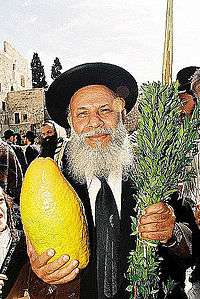Yemenite citron

The Yemenite citron (Hebrew: אֶתְרוֹג תֵּימָנִי, etrog teimani)[1] is a distinct variety of citron, usually containing no juice vesicles in its fruit's segments. The bearing tree and the mature fruit's size are somewhat larger than the trees and fruit of other varieties of citron.[2][3][4]
| Citron varieties |
|---|
| Acidic-pulp varieties |
| Non-acidic varieties |
| Pulpless varieties |
| Citron Hybrids |
| Related articles |
Classification, genetics and purity
Despite its major differences from standard varieties of the most common original citron, the Yemenite citron was attested by a group of citrus and genetic experts to be a true variety of citron, and possesses a close genetic relation with the rest of the types. A brief documentation of this study was presented at the Global Citrus Germplasm Network.[5]
Current research shows that grafting should not result in hybrid speciation, which can only be obtained by cross breeding. By plants this is achieved through cross pollination, which is applying the pollen of one variety or species to the style of another type of plant before anthesis, planting the seeds of this particular flower would result to a complete mix of traits. In light of this, there is no reason to question one citron variety more than another, especially while the above genetic study shows equal purity for all.
In particular it shows that the Yemenite kind is highly affiliated with the Moroccan citron which is traditionally cultivated in a remote area in the absence of any other citrus species.[6] Since the Moroccan citron couldn't have been grafted nor bred with any different kind of citrus, the Yemenite kind, which is genetically similar to it, should be regarded as equal.
note the lack of pulp in the Yemenite kind.
Some argue that the absence of pulp of the Yemenite kind is clear evidence for its genetic purity, and that all other varieties developed a pulp due to being grafted upon lemon or sour orange rootstock.[7] This assertion is contested by virtue of the fact that the fruits of a Yemenite tree at the Citrus Variety Collection contain no pulp despite being grafted on rootstock of Yuma Ponderosa Lemon.[4]
Role as Etrog
Although other varieties of pulpless citron, such as Buddha's hand, can be found in India and China,[8] most Jewish cultures are not aware of them, therefore the Yemenite citron is the only pulpless citron used as etrog. According to the Yemenite tradition that is claimed to trace back to The First Temple, their kind was with them all the times.

Etrog haCushi
Etrog haCushi (Hebrew: אֶתְּרוֹג הַכּוּשִׁי) is mentioned in the Mishnah as well as in both the Babylonian (Succa 36a) and the Jerusalem Talmud (Succa 3:6). The most common interpretation is that the Biblical Cush refers to Ethiopia,[9] and therefore Etrog haKuschi should also refer to something which could be called the Ethiopian citron.
The Ethiopian Jews did not follow the mitzva of four species, even though they did anticipate the Sukkot festival, as well as the rest of the Jewish ethnic divisions. This may have been due to their lack of ability to procure the species. Some believe that this is due to some Karaite influence, whose biblical interpretation indicates that the four species are only used as roofing for a sukkah (the S'chach), and not for a separate waving ritual.[10]
However, the Yemenite citron is available in Ethiopia and its markets, where it is sold for consumption.[11] According to Erich Isaac, the late researcher of citrus distribution, the Yemenite citron is synonymous with the Ethiopian citron, as a result of Ethiopian rule of Yemen in the past.[12][13]
Areas of cultivation
Growing un-grafted citrons in Yemen has some associated difficulties, particularly since citron is a highly susceptible plant.
The most common rootstock types that are currently used to graft citrus in Yemen are Sour orange (Citrus × aurantium) and Rough Lemon (Citrus jhambiri),[14] which are very helpful to prevent exocortis in Northern Yemen. The specific rootstock species are not carefully documented in Yemen and therefore difficult to detect, after the graft is done. However, throughout Yemen, grafting is not enough to prevent infection by Phytophthora gummosis, which can nonetheless still be controlled by appropriate horticultural practices.[15]
The main cultivation area of the Yemenite citron today is Israel, where it is highly sought out for its beauty and large size.
References
- ↑ In the Yemenite tradition, the word אתרוג is pronounced with a dotted ת and שוא נח.
- ↑ Hebrew Forum with Participation of Growers
- ↑ A Man Holds A Yemenite Citron against his Head
- 1 2 "yemen". ucr.edu.
- ↑ "The Search for the Authentic Citron (Citrus medica L.): Historic and Genetic Analysis" (PDF). ashspublications.org.
- ↑ The Report by professor Eliezer E. Goldschmidt, in Halichoth Sadeh תשנ"ח, is available for reading in Otzar haChochma.
- ↑ Agitation for the Yemenite Citron, Hebrew
- ↑ See "Chhangura" at The Purdue University website.
- ↑ Bar Ilan University article about the subject.
- ↑ David Schperber
- See also שאילת שלמה
- ↑ Ari Greenspan
- ↑ Yemen Times
- ↑ "Influence of Religion on the Spread of Citrus: The religious practices of the Jews helped effect the introduction of citrus to Mediterranean lands". Science. 129 (3343): 179. doi:10.1126/science.129.3343.179.
- ↑ Virus and virus-like diseases of citrus in the Near East region... for Southern Yemen
- ↑ "Ch27 - Greening and other virus and virus-like diseases in northern Yemen: conclusion". fao.org.
External links
- The secret life of etrogs by the Jewish Journal
- UJA of Greater Toronto
- Yemenite Etrog on Flickr
- Blog
- A Yemenite website saying that there are grafted Yemenite citrons in Israel The same
- Pictures of orchard growing Yemenite variety
- Blog containing pictures of bloom and fruit on the tree